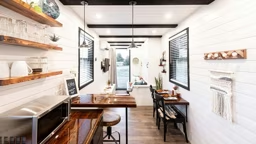
There's a saying: “You get what you pay for.” This holds especially true in the realm of fixer-upper retreats. They can be laden with challenges and surprises, and they frequently end up requiring substantial amounts of labor and dollars. But there are definitely rewards to be had from these diamonds in the rough, including a lot more cabin for the money compared to what you would spend on a place in tip-top shape. Here are a few guidelines to consider before taking on a fixer-upper.
See also How to Weatherproof Your Cabin
1. BEFORE PURCHASING a fixer-upper, be sure to get a home inspection and, if possible, an appraisal. Home inspectors and appraisers might tend to err on the side of caution, and go a little overboard with potential pitfalls, but it is better to be prepared rather than blindsided by the labor and material costs that lay ahead.
2. ORDER PROJECTS by priority. Start with the project that could cause the most damage and expense later on down the road if left unfixed. Things to think about: electrical systems, the basement, the roof, exterior walls and aging equipment.
3. HOMEOWNERS WITHOUT significant building experience may want to tackle fairly simple upgrades themselves, such as replacing light fixtures, faucets, wall paint and even refinishing cabinetry. But for the big projects, such as a new roof, knocking out walls and plumbing modifications, hire professionals in the trades.
See also How to Fund Cabin Construction
4. GET ESTIMATES from several experienced contractors who are insured and bonded. Request and check their references. Rick Stockmann of Specialty Built Construction advises, “Add 20% to whatever price someone quotes you. Some of the remodels I have done have had carpenter ants in the walls, dictating large sections of structural work. Once you open up a wall, electrical, plumbing, insulation and windows need to be redone to meet current code.”
5. BE PATIENT. Even if you are not living in the midst of a renovation mess, try to be calm and accept that these projects take time, generally more so than new construction. Just when you think you are gaining on it, another set of challenges will likely emerge.
6. THE RIGHT STUFF, such as tools, equipment and, most importantly, experience are essential. Consider renting or borrowing tools that will be needed only once or twice during the project to tackle very specific tasks.
5. BE PATIENT. Even if you are not living in the midst of a renovation mess, try to be calm and accept that these projects take time, generally more so than new construction. Just when you think you are gaining on it, another set of challenges will likely emerge.
6. THE RIGHT STUFF, such as tools, equipment and, most importantly, experience are essential. Consider renting or borrowing tools that will be needed only once or twice during the project to tackle very specific tasks.
See also How to Pave a Cabin Pathway
7. A NEW ADDITION is a relatively simple upgrade. You are able to live in the original space and hang heavy plastic to keep you separated from the construction mess going on adjacent to your living quarters. There will be dust infiltration to deal with, but that’s part of any remodel.
8. LAST BUT NOT LEAST, before you fall in love, make sure you are ready for a long-term commitment: be prepared to give it your all for the duration of the renovation, for better or worse, in good times and bad … in the end you will reap the rewards for years to come.
See also Your Seasonal Garden Checklist










